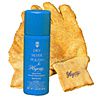
Caring for your Sterling Silverware
Related departments: Silver Polish | Silver Storage Bags | Silverware Chests
Washing sterling silver
Wash your sterling silverware immediately after each use. This helps to avoid staining and tarnishing that some foods accelerate. You can either hand-wash your silverware (recommended), or use the dishwasher. You can use the dishwasher even for gold accented patterns.
Hand-washing sterling
Use a mild dishwashing liquid, and dry your silverware completely with a soft cloth-like flannel. Always wash your sterling and stainless separately, and only store silverware after it has cooled.
Dishwasher Tips
Before you use the dishwasher, wash your silverware by hand the first four or five times of use. This will prevent the miniscule amount of copper from forming brown spots on your sterling.
Rinse all excess food off of the silverware, and do not let sterling and stainless pieces touch. Avoid lemon-scented detergents, those containing chlorides, and use slightly less than recommended. Remove the silverware before before the dry cycle, and hand-dry with the soft cloth.
Storing your Silverware
If you use your silverware regularly, store it in a clean drawer free from moisture. If you store your silver for a length of time, place it in either flannel flatware rolls, or in a wooden storage chest with protective lining.
Never wrap your silverware in any type of plastic, rubber bands, or newspaper. These items contain high amounts of sulfur which will accelerate tarnishing
Avoiding Tarnish
The best way to avoid tarnish is to use your silver! Constant use of your silverware will keep it bright and shiny, and will certainly enhance your dining table.
Tarnish is caused by certain foods that contain sulfides, such as: Eggs, fruit juices, tomatoes, vinegar, ketchup, salt, salty foods (such as butter), mustard, salad dressings, and tomato sauces. If these foods remain on your silverware for a length of time, they will cause your silver to tarnish. Salt should be rinsed off immediately to avoid spotting.
Polishing your Silverware
If you use your silverware regularly, you will only have to polish it once or twice a year, at most. Here are a few tips for silver polishing:
- Use a very soft cloth, such as flannel, to polish your silverware.
- We recommend using a non-abrasive foaming paste cleaner, or Hagerty's Spray Polish. Avoid all-purpose metal cleaners, and dip cleaners.
- Avoid excess rubbing, and be sure to rub lengthwise, never in a circular motion or crosswise.
- Try to keep polish away from gold accents, if you have those accents on your items.
Like most precious metals, silver will scratch and chafe as it is used. This is normal, and adds to the silver's character. The scratches will eventually give silver its patina, the soft, rich glow that is prized in old silver.
